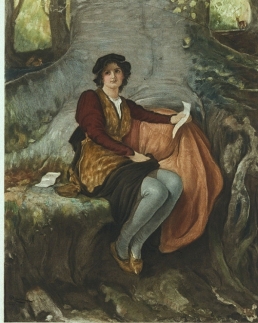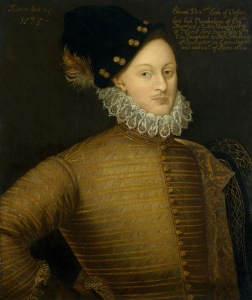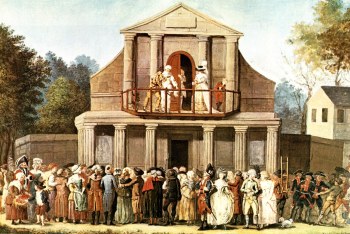By: Justin Borrow

Sexuality and gender are prominent themes in Shakespeare’s plays. Depending on the genre of the play, sexuality and gender are used as either a tool of manipulation, a form of propaganda or sometimes both. During the time of Shakespeare, there was a social construct of gender and sexuality norms just as there are today. There was a hierarchy of sexes and each had their own role in society. Men were masculine, they were not ruled by emotion, they were strong and hard working. Women belonged in the home, they were ruled by men and by their emotions and therefore were thought to often make bad decisions. By blurring the lines between sexuality and gender in his plays, Shakespeare deconstructs these norms to display their ambiguity. Masculine men can play effeminate female roles (which they did on stage) and effeminate women can play masculine male roles. Looking at both Richard III and As You Like It as major examples, this paper will show the different ways sexuality and gender are used to manipulate characters, alter the action of the play and deconstruct the social norm of gender and sexuality and how they vary depending on the genre of the play.
During the time when William Shakespeare was alive and writing, there were social norms about gender and sexuality that existed similarly as they do today. A major difference is that today there are feminist movements out to abolish gender inequality whereas during the 16th century when Shakespeare was writing in his prime, women were fully aware of their role in society and generally shared the same viewpoint as the men did. It was not seen as sexist at this time, it was the way it was.
A Woman’s place was within doors, her business domestic…Women…themselves accepted this divorce between the private (feminine) and public (masculine) sphere and, despite the recent precedents of Mary Queen of Scots, Mary Tudor and Elizabeth, they shared the age’s distaste…for the notion of women’s involvement in politics. (Gajowski 53, [Keeble] 1994, 186)
Shakespeare sought to defeat these norms, he sought to show that sexuality and gender are ambiguous and mutable. He could be viewed as a feminist in today’s standards because of his attempt to deconstruct the unwritten rules about gender and sexuality in society. Many scholars question Shakespeare’s sexuality and whether or not he had homoerotic tendencies based on some of his sonnets which are believed to have been written about men. Regardless, whether this is true or not we shall never know, however, we do know that he deconstructed the norm of gender and sexuality within his plays. The method he used to deconstruct sexuality and gender depended on the genre of the specific play.
Shakespeare wrote a variety of genres from romance to tragedy to history to comedy. Each genre had its own way of blurring the lines of sexuality and gender. It seemed each genre had its own set of rules and methods for how sexuality and gender were displayed and the limitations they possessed. Although there are women who face tragic fates in Shakespeare’s tragedies they are mainly dominated by men. Examples such as Titus Andronicus, Hamlet, and Othello where the male characters’ fates predominately rule the plot of the plays. There is also a “detachment from sexual violence” (Gajowski 71) in his tragedies. In Othello for example, when he murders Desdemona, Gajowski explains that the violence is uncontrollable. “In Othello [5.2.1] impending male violence toward the female is conceived of and articulated as an impersonal force beyond the control of the male protagonist.” (Gajowski 71) Tragedy favoured the side of the males with them mainly controlling the plot and their fates holding the main focus, however, his comedies took a different approach. “If the dark realm of Shakespeare’s tragedies is essentially men’s territory, pride of place in the bright panorama of his comedies must surely belong to the women.” (Pitt, 75) Shakespeare’s comedies are predominantly ruled by his women, it is here where we see the reversal of gender roles such as Titania’s power in a Midsummer Night’s Dream. Although Oberon is King of the faeries he can be read as being weaker than his wife. He bends to her will and although he argues with her and makes demands he never truly gets what he wants. While reading the chapter Women in the Comedies and Last Plays by Angela Pitt, She makes an interesting point in regards to the role of Women in Shakespeare’s plays and the possible reason Shakespeare chose women for his comedies. She writes:
Why should the women leap into prominence? One reason may be that Shakespeare found their traditional attributes of modesty, intuition and high-spiritedness highly suitable material for his comedies, and in varying blends and degrees, all his comic heroine’s have these characteristics. They never go beyond what an Elizabethan audience would have found acceptable in a woman: it is rather that Shakespeare exalts the positive, rather than the negative traits. Any women that go against prevailing conventions are redeemed by the end of the play. (Pitt, 75)
This quote highlights my point earlier that genre dictates the limitations of the play and the boundaries able to be crossed. Tragedy is of such serious nature that there are stricter guidelines. In Presentism, Sexuality and Gender in Shakespeare Evelyn Gajowski discusses why comedy can stretch those boundaries and blur the lines even more when discussing sexuality and gender. She writes:
Comedy provides a safety net that allows the unfamiliar or the unacceptable to be presented in public, because the stakes are perceived to be lower than in tragedy. Consequently the outrageousness or unthinkability of some images-their potential for queasiness-can be excused as inconsequential playfulness. This allows greater free play than in work that is taken more seriously and is more closely scrutinized as a result. (Gajowski 133)
A great example of this is in A Midsummer’s Night Dream with Puck, he causes much of the chaos in the play and even goes as far as to make Titania commit bestiality with Bottom who has been transformed into an ass. This sexual taboo could be seen as offensive by the audience but because it’s a comedy it can be forgiven. Puck at the end of the play gives his famous monologue “If these shadows have offended, think but this and all is mended.” (Act 5 scene 1) Puck keeps his good faith as Titania is restored by the end of the play and back in her strong, dominating role as leading woman.
Not only does Shakespeare challenge the social norms of gender roles in his comedies but he also challenges the ambiguity of sexuality. In As You Like It, Rosalind runs away to the forest of Arden dressed up as a boy named Ganymede. Phoebe falls in love with Ganymede unaware that it is actually Rosalind. This creates an interesting piece of metatheatre because the character of Rosalind would have been played by a young, feminine looking boy. Therefore not only is there a homoerotic relationship in the play between the female characters Phoebe and Rosalind but also on the stage by the two male actors portraying the women. Phoebe’s inability to notice that Ganymede is actually a girl, shows the ambiguity of sex, it shows that male and female are mutable, they are one in the same.
Shakespeare also uses sexuality and gender roles as a tool of manipulation. The manipulator uses sexuality and gender to twist the action of the play in their favour. Richard III is the most prominent example where this is present in Shakespeare’s work. Sexuality as it is known in the context of society is broken, it no longer becomes about love or lust but for the gain of power. After killing her husband and her father in law in battle Richard successfully seduces Anne, explaining that he only killed them out of love for her. Despite her hurling insults at him he persists. A notable moment is in Act 1 scene 2 when Richard opens his shirt and holds his sword to his breast telling Anne to kill him if she will not love him because he’d rather die than not have her. He says: “Nay, do not pause: for I did kill King Henry-But ‘twas thy beauty that provoked me.” (Act 1 scene 2) When she drops the sword he says: “Take up the sword again, or take me.” (Act 1 scene 2) It is blatant that Richard does not truly love Anne but that he vies for her love for his own personal gain. When Anne accepts his ring on her finger and exits Richard states “Was ever woman in this humor woo’d? Was ever woman in this humor won?” (Act 1 scene 2) He continues on celebrating his successful seduction of Anne. In this case, although sexuality has lost its proper use, gender roles have not. Although Richard is described as feminine looking, he exhibits the traits of a masculine being, one who gains power and is not ruled by his emotions where as Anne exhibits the traits of an effeminate being, one who seems to be strong willed but is weak and ruled by her emotions. She knows that Richard is evil yet she allows his words to captivate her and gives into his will. She allows herself to be seduced by his sexuality. In Shakespeare and Gender Phyllis Rackin says:
This exchange dramatizes what will be a major source of Richard’s theatrical power- his appropriation of the woman’s part. Characterized throughout in terms of warlike masculinity and aggressive misogyny, Richard also commands the female power of erotic seduction. His monopoly of both male and female sexual energy is vividly portrayed in his seduction of Anne. (Rackin 270)
The gender roles in Richard III are quite reflective of Elizabethan society. Anne is angry at Richard for his heinous crimes yet she cannot make a sound decision because of her emotions that Richard is bringing out of her. Shakespeare deconstructs sexuality by taking it out of it’s norm in society. Rather than it be used for seduction for sex or for love, it’s seduction for love which shows that in fact it is a tool that can be dangerous if wielded by the wrong person such as Richard. Although the gender roles have not changed per se the women of the play have been displaced. In Shakespeare and Gender Phyllis Rackin discusses how Shakespeare “transforms” the women of history and how they are represented, she writes:
The reconstruction of history as tragedy in Richard III is accompanied by a remarkable transformation in the representation and placement of female characters. Paradoxically, even as the female characters are ennobled, they are also disempowered. On the one hand women are much more sympathetically portrayed. On the other, they lose their vividly individualized voices and the dangerous theatrical power that made characters like Joan and Margaret in the Henry VI plays potent threats to the masculine project of English history-making. (Rackin 267)
Shakespeare not only deconstructs sexuality and gender from their norms in society to use them as tools for power but he also uses them as a form of English propaganda. During the time of Shakespeare’s life, the English were hostile with the French forces and Shakespeare used his plays to disempower the French as much as he could. “Shakespeare repeatedly represents the French forces as effeminate.” (Gajowski 70) By portraying the French as effeminate it is a message that they are weak and able to be conquered by England. “Shakespeare represents the entire French Kingdom as a woman to be conquered by the masculine force of the English army.” (Gajowski 70) In this case he uses gender and the attributes of it to portray a certain image about the French. This would have pleased any of the political figures in Elizabethan England who would have been watching these plays. In Shakespeare’s Henry V, the French are seen as a weak force against England. In Act II scene 4, the King of France says: “Thus comes the English with full power upon us;” (2.4. line 1) and he continues talking about the fear the French have for the English. “For England his approaches makes as fierce as waters to the sucking of a gulf.”(2.4. lines 9-10) Here he compares the approaching English force to rushing water. He claims they must be strong, but it is apparent that the French are portrayed to fear the English. This would have evoked a strong reaction from the English audience watching, showing that the French, like women, are ruled by their fear and have little might.
Shakespeare saw the social norms of sexuality and gender in Elizabethan society and sought to deconstruct them to bring a new viewpoint on them. He was the Elizabethan version of a modern day feminist. He showed in his work that sexuality and gender are ambiguous tools that could be used for more than what society said they could be. He showed that men could be women and women could be men, that gender roles can be reversed and that no social norm was concrete. Depending on his genre, his method of deconstructing sexuality and gender changed and he was aware that he could go further within his comedies because of their light-hearted plot lines. He used sexuality and gender not only ambiguously but also as a powerful tool that could be wielded by one to gain power over another for political gain. Lastly, he used sexuality and gender as English propaganda to show that England was stronger than France and that they would always be victorious. Shakespeare’s work and his ability to deconstruct sexuality and gender within it, proves that the social hierarchy is one that is not permanent and can be broken.
BIBLIOGRAPHY
Barker, Deborah, and Ivo Kamps. “Engendering the Tragic Audience: The Case of Richard III.” Shakespeare and gender: a history. London: Verso, 1995. 263-282. Print.
Gajowski, Evelyn. Presentism, gender, and sexuality in Shakespeare. Basingstoke England: Palgrave Macmillan, 2009. Print.
Orgel, Stephen, and Sean Keilen. Shakespeare and gender. New York: Garland Pub., 1999. Print.
Pitt, Angela. Shakespeare’s women. Newton Abbot Devon: David & Charles ;, 1981. Print.
Shakespeare, William. ” Henry V, Act II, Scene 4 :|: Open Source Shakespeare.” OpenSource Shakespeare: search Shakespeare’s works, read the texts. N.p., n.d. Web. 14 Mar. 2013. <http://www.opensourceshakespeare.org>
Shakespeare, William, and Peter Holland. A midsummers night’s dream. Oxford: Oxford University Press, 1998. Print.
Shakespeare, William. As you like it;. Rev. ed. New Haven: Yale University Press, 1954. Print.
Shakespeare, William. King Richard III. Champaign, Ill.: Project Gutenberg, 1999. Print.





